Most Americans pay only a moderate amount of attention to what is traditionally referred to as hard news coverage of international affairs, politics and events in Washington, local government, and business and finance. A smaller group of news consumers less than a third of the public (31%) consistently focuses on these types of stories. At the other end of the spectrum, about one-in-ten Americans (13%) do not follow these subjects at all, preferring other kinds of news or no news at all.
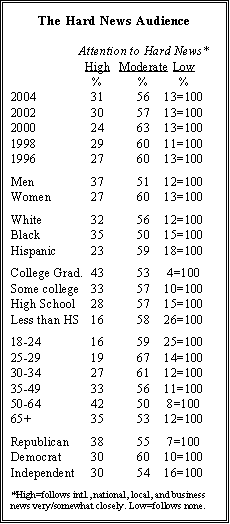 Over the past eight years, the hard news audience has ranged in size from a low of 24% in 2000 to its current level of 31%, with the increase over the past four years driven largely by the rise in interest in international news. While a minority overall, these hard news enthusiasts make up a majority of the audience for a number of news programs, and express distinctly different attitudes and preferences about what they want in the news.
Over the past eight years, the hard news audience has ranged in size from a low of 24% in 2000 to its current level of 31%, with the increase over the past four years driven largely by the rise in interest in international news. While a minority overall, these hard news enthusiasts make up a majority of the audience for a number of news programs, and express distinctly different attitudes and preferences about what they want in the news.
The attentive audience for political, international and financial news tends to be better educated and middle-aged. Whites and blacks express comparable levels of interest (32% for whites, 35% for blacks), but Hispanics are less apt to follow hard news closely (23%). Republicans pay somewhat more attention (at 38%) than do Democrats or independents (30% each).
Young people those age 18-24 are considerably more likely than those in other age groups to be disengaged from hard news, with 25% saying they do not follow any of the four types of news. More people in this age group pay no attention to hard news than express strong interest (25% vs. 16%). By comparison, far fewer people in their late 20s (age 25-29) are disengaged from hard news (14%). The highest level of attention is seen among those aged 50-64, where 42% are highly attentive.
Where Hard News Consumers Go
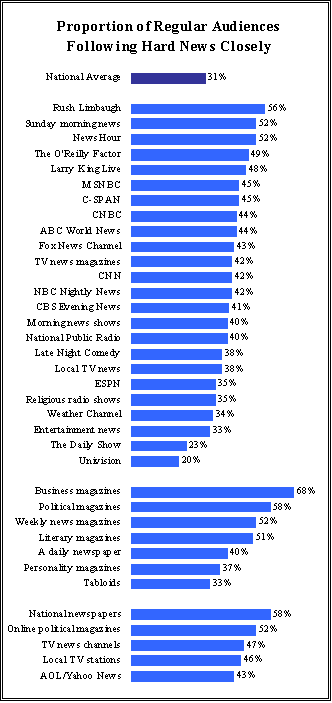 Most news organizations attract a wide range of news consumers, including the hard news core and those who are less interested in such news. But some stand out for their high proportion of hard news viewers and readers. Among the regular audiences for broadcast programs, Rush Limbaugh’s radio show (56% attentive), the Sunday morning interview programs (52%), the NewsHour (52%), the O’Reilly Factor (49%), and Larry King Live (48%) have especially large numbers of hard news consumers.
Most news organizations attract a wide range of news consumers, including the hard news core and those who are less interested in such news. But some stand out for their high proportion of hard news viewers and readers. Among the regular audiences for broadcast programs, Rush Limbaugh’s radio show (56% attentive), the Sunday morning interview programs (52%), the NewsHour (52%), the O’Reilly Factor (49%), and Larry King Live (48%) have especially large numbers of hard news consumers.
In the print media, the regular audience for business magazines stands out for its high proportion of the hard news consumers (68%). But so too do the readers of political magazines such as the New Republic and the National Review (58% attentive), the weekly news magazines such as Time and Newsweek (52%), and literary magazines such as the New Yorker, the Atlantic, and Harper’s (51%).
And the regular audiences for news from Internet sources also are disproportionately made up of those interested in hard news. Nearly six-in-ten (58%) of those who log on to the websites of national newspapers are hard news consumers. Among those who regularly read online political magazines such as Slate.com and the National Review.com, 52% fall into this category. So do large proportions of the audiences for network TV news websites (47% highly attentive), local TV websites (46%), and the news pages of Internet hosts such as AOL and Yahoo (43%).
How People Like Their News
Beyond the types of news that interest people, the choices made by news audiences are driven by two general kinds of preferences. One is how they like to get the news, including choices with regard to schedule and format. The other is what people want in news content, including choices among levels of detail, ideological viewpoints, debate and argument, humor, and human interest.
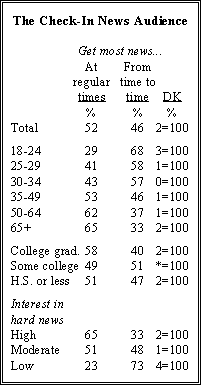 Americans’ busy lifestyles, combined with on-demand news sources, means that people fit news into their schedules in different ways. About half (52%) say they mostly get their news at regular times of the day, while nearly as many (46%) say they are more the kind of person who checks in on the news from time to time. These attitudes have been stable since 2002.
Americans’ busy lifestyles, combined with on-demand news sources, means that people fit news into their schedules in different ways. About half (52%) say they mostly get their news at regular times of the day, while nearly as many (46%) say they are more the kind of person who checks in on the news from time to time. These attitudes have been stable since 2002.
Older Americans express a preference for getting the news at regular times, a function both of the news habits they grew up with and a more settled lifestyle. By nearly two-to-one (65%-33%), those age 65 and older say they watch or listen to the news at regular times. By contrast, the youngest respondents in the survey those 18 to 24 show exactly the opposite pattern, with 68% saying they generally check in on the news from time to time (just 29% watch or listen at regular times). Getting news on a more regular schedule is also characteristic of college-educated people.
Most Americans watching TV news keep the remote control handy, flipping to other channels when they are not interested in the topic of the moment. Overall, 62% of the public says they watch the news this way, a habit that has neither grown nor dissipated over the past six years. Even among those who get the news on a regular schedule as opposed to those who check in from time to time 54% say that the channel changer is often at hand. Among the news grazers, a solid majority (72%) say they watch the news with their remotes at the ready.
Overall, fewer than one-in-four Americans (23%) are steady news watchers, saying they watch on a regular schedule and don’t flip channels. At the other end of the spectrum are 33% who truly graze the news checking in from time to time when convenient, and ready to change the channel whenever they don’t find the subject interesting.
Appointment News vs. Grazing
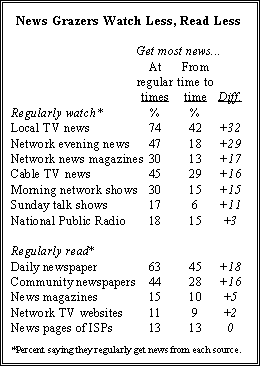 People who get the news at regular times of the day make up the bulk of the audience for local and network TV news broadcasts. Three-quarters (74%) watch the local television news regularly, and nearly half (47%) regularly watch the network evening news programs.
People who get the news at regular times of the day make up the bulk of the audience for local and network TV news broadcasts. Three-quarters (74%) watch the local television news regularly, and nearly half (47%) regularly watch the network evening news programs.
People who “check in” on the news are far less likely to watch broadcast and cable news, particularly the network evening news (only 18% watch regularly). There are similar gaps with respect to morning news programs, Sunday talk shows, and network news magazines such as 60 Minutes and 20/20; each of these sources is watched far more often by people for whom news is part of a daily schedule. And 63% of this group reads a daily newspaper regularly, compared with 45% of those whose news consumption is unscheduled.
Radio and the Internet stand apart, however, as relatively important sources for those who pick up news from time to time. News grazers listen to NPR at about the same rate as those who get their news at regular times (15% vs. 18%). Grazers also log onto major news websites in roughly the same numbers as those who get news on a schedule.
Images vs. Words
When asked to choose which way of getting the news provides the best understanding of major news events, most Americans (55%) express a preference for seeing pictures or video footage showing what happened; 40% say they learn more from reading or hearing the facts about what happened.
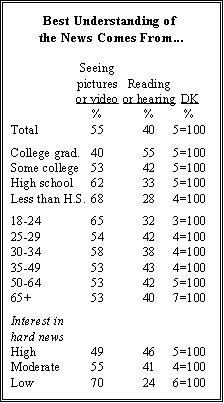 College graduates express a preference for words over pictures (by 55% to 40%), while those with no college experience say they get a better understanding from seeing pictures (by 64%-32%). The youngest survey respondents (18-24) prefer pictures by a two-to-one margin, but from ages 25 and up, there is no association between age and preference for pictures. Among the best educated respondents (those with a college degree or more), young people are just as apt to prefer reading and hearing the news as older people are.
College graduates express a preference for words over pictures (by 55% to 40%), while those with no college experience say they get a better understanding from seeing pictures (by 64%-32%). The youngest survey respondents (18-24) prefer pictures by a two-to-one margin, but from ages 25 and up, there is no association between age and preference for pictures. Among the best educated respondents (those with a college degree or more), young people are just as apt to prefer reading and hearing the news as older people are.
People who prefer reading and hearing are more likely to be found among the regular audience for most print media, for NPR, and for news-oriented websites. But for the most part, those who say they better understand the news through pictures are not disproportionately likely to frequent television news sources; with very few exceptions, these media draw about equally well from people who like reading and hearing about the news.
Many Want More Than the Headlines
Four-in-ten Americans say that for major news stories, they usually want in-depth analysis of the news in addition to the headlines and basic facts. A similar proportion (37%) say they prefer the headlines plus some reporting on the facts, but not in-depth analysis. Far fewer people (18%) say they prefer just the headlines.
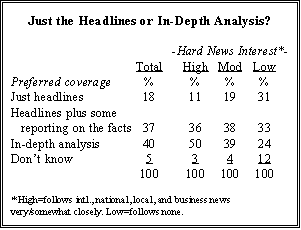 The preferences of hard news consumers are not markedly different from those who only express moderate interest in hard news. Half of hard news consumers say they like in-depth analysis, while 36% prefer to get the headlines and some coverage of the facts. This represents only a bit more emphasis on analysis than among the majority who are only moderately interested in hard news (39% of whom also prefer in-depth coverage). Only those who are disengaged from hard news altogether show a clear preference for simpler news presentations.
The preferences of hard news consumers are not markedly different from those who only express moderate interest in hard news. Half of hard news consumers say they like in-depth analysis, while 36% prefer to get the headlines and some coverage of the facts. This represents only a bit more emphasis on analysis than among the majority who are only moderately interested in hard news (39% of whom also prefer in-depth coverage). Only those who are disengaged from hard news altogether show a clear preference for simpler news presentations.
There are a handful of news outlets that attract a disproportionate share of the in-depth audience. Fully 63% of regular NewsHour viewers say they want the news provided with in-depth analysis from experts, far above both the national average and the audiences for all other television news programs. The Internet, particularly the websites of major national newspapers like the New York Times and Wall Street Journal, also draws significant interest from those who desire in-depth coverage.
News Styles: From Serious to Lighthearted
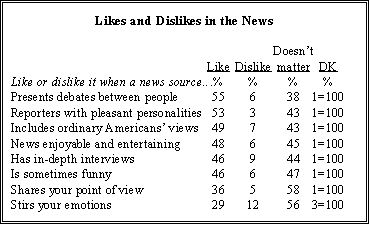 Americans like many different styles of presenting the news, and their preferences range from the serious to the lighthearted. A solid majority (55%) likes debates between people with different points of view, and 46% like in-depth interviews with leaders and policymakers. But comparable numbers like news presented by reporters and anchors with pleasant personalities (53%) and from news sources that are entertaining (48%) or funny (46%).
Americans like many different styles of presenting the news, and their preferences range from the serious to the lighthearted. A solid majority (55%) likes debates between people with different points of view, and 46% like in-depth interviews with leaders and policymakers. But comparable numbers like news presented by reporters and anchors with pleasant personalities (53%) and from news sources that are entertaining (48%) or funny (46%).
About half of the public (49%) likes news sources that present the views of ordinary Americans. Fewer (36%) express a positive opinion of news sources sharing their point of view on politics and issues; a majority (58%) says this does not matter to them. Just 29% of Americans want to be moved emotionally by the news, while 12% dislike news aimed at stirring the emotions.
Regardless of their views of various styles of presenting the news, the vast majority of Americans (87%) say they “want the news to contain information that is helpful in my daily life.” Nearly half of Americans (47%) completely agree with that statement, while 40% mostly agree. Just 11% reject the idea that news should have information that is helpful in daily life.
More Signs of Cynicism
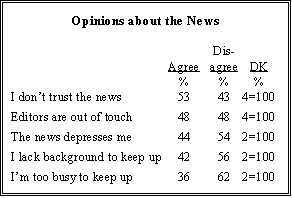 The public is increasingly cynical toward the news media, as reflected in the slumping credibility ratings for many outlets. More generally, a majority of Americans (53%) agree with the statement “I often don’t trust what news organizations are saying.” And while 43% disagree with that statement, just 9% completely disagree with it.
The public is increasingly cynical toward the news media, as reflected in the slumping credibility ratings for many outlets. More generally, a majority of Americans (53%) agree with the statement “I often don’t trust what news organizations are saying.” And while 43% disagree with that statement, just 9% completely disagree with it.
Feelings of mistrust of news organizations are fairly widespread. About six-in-ten Republicans (58%) say they often do not trust what news organizations are saying, but nearly half of Democrats share that opinion (47%). Older men, those age 50 and older, are particularly cynical toward the news media: 62% say they often do not trust news organizations. Younger women are decidedly less negative, with 35% of women under age 30 expressing mistrust for news outlets.
A relatively large percentage of the public (48%) also expresses the opinion that “people who decide what to put on TV news or in the newspapers are out of touch with people like me.” This view is prevalent among older Americans, who comprise the bulk of the audience for network evening news and several other news sources. A majority (55%) of those age 50 and older believe news organizations are out of touch, compared with 44% of those under age 50.
Somewhat fewer Americans (44%) say they are often depressed by the news, while a majority (54%) disagrees. There is a wide gender gap in these attitudes, as a majority of women (53%) say they find the news often depressing. By comparison, only about a third of men (34%) acknowledge getting depressed by the news.
Barriers to Following the News
Americans’ increasingly crowded schedules are often cited as a major reason why some people do not keep up with the news, but a lack of background information is actually a bigger factor. About four-in-ten (42%) say they often do not have enough background information to follow stories, while somewhat fewer (36%) say they are often “too busy” to keep up.
Half of those with a high school education cite a lack of necessary background information as a barrier to following the news; fewer than three-in-ten college graduates agree (27%). However, young people are not significantly more likely than older Americans to cite a lack of background as a reason for not keeping up with the news.
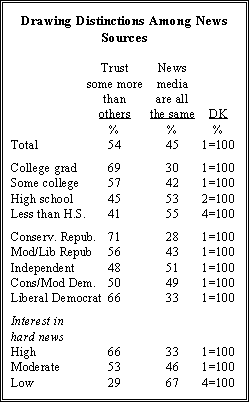 Age is a major factor in the question of whether people are too busy to follow the news, but education influences these attitudes as well. Half of those under age 25 say they are often too busy to follow the news, while just 28% of those 65 and older cite time constraints as a reason for not keeping up. Less educated Americans also more often cite a lack of time as a reason for not following the news.
Age is a major factor in the question of whether people are too busy to follow the news, but education influences these attitudes as well. Half of those under age 25 say they are often too busy to follow the news, while just 28% of those 65 and older cite time constraints as a reason for not keeping up. Less educated Americans also more often cite a lack of time as a reason for not following the news.
Are News Media All the Same?
Most Americans look at the media landscape and discern important distinctions among sources, but a sizable minority (45%) views the news media “as pretty much the same to me.”
Those at both ends of the political spectrum perceive meaningful differences among news organizations, and trust some more than others. Seven-in-ten conservative Republicans (71%) say there are a few news sources they trust more than others, and nearly as many (66%) liberal Democrats share that view.
Independents and moderates, by contrast, are more divided in their outlook. Roughly half of independents (51%), and conservative and moderate Democrats (49%), regard news organizations as fairly similar. Most moderate and liberal Republicans (56%) say there are a few news sources they trust more than others, but many (43%) do not differentiate among news organizations.
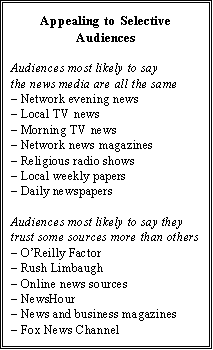 Two-thirds (66%) of those with a strong interest in hard news perceive clear distinctions among news outlets, but only about half (53%) of those with a moderate interest in hard news agree. And those with no interest in hard news overwhelmingly view news organizations as “pretty much the same.”
Two-thirds (66%) of those with a strong interest in hard news perceive clear distinctions among news outlets, but only about half (53%) of those with a moderate interest in hard news agree. And those with no interest in hard news overwhelmingly view news organizations as “pretty much the same.”
By their nature, the news outlets that appeal to narrower, hard news-oriented audiences are drawing viewers who see important differences between the credibility of news organizations. By large margins, people who watch the O’Reilly Factor and the NewsHour say they trust certain sources more than others, as do those who regularly listen to Rush Limbaugh and read online news sources and weekly news magazines. By comparison, regular viewers of the major network news programs and readers of daily newspapers are less discriminating, though even here most say they trust some sources more than others.
Most Ambivalent Toward News With a View
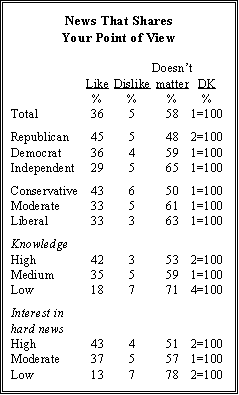 Most Americans (58%) do not care if the news reflects their own viewpoint on politics and issues. But the minority of Americans that like the news to reflect their own views (36%) are highly selective in their choices of news outlets.
Most Americans (58%) do not care if the news reflects their own viewpoint on politics and issues. But the minority of Americans that like the news to reflect their own views (36%) are highly selective in their choices of news outlets.
More members of both parties than independents and more Republicans than Democrats say they like the news to share their point of view. Roughly four-in-ten conservatives (43%) likes news that reflects their own opinions, compared with a third of moderates and liberals.
More generally, people who pay close attention to hard news express a preference for news that suits their point of view. Among those who follow international, national, local government, and business news, 43% say they like news with their point of view. Among those who follow none of these topics closely, just 13% say the same.
News With a View Left and Right
There are several key differences in some of the news consumption habits of liberals and conservatives who like the news to reflect their political views, although they turn to some major news outlets (network evening news, among others) in about the same numbers.
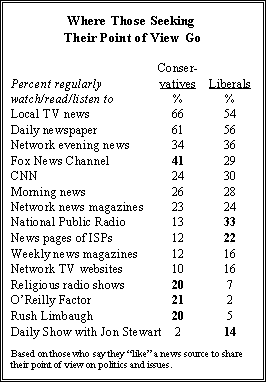 Among specific programs, the O’Reilly Factor, religious radio shows and Rush Limbaugh’s show are important news sources for conservatives especially those who like the news to reflect their views. And Comedy Central’s Daily Show, viewed regularly by only 3% of Americans overall, is a staple for 14% of liberals who like news that reflects their point of view.
Among specific programs, the O’Reilly Factor, religious radio shows and Rush Limbaugh’s show are important news sources for conservatives especially those who like the news to reflect their views. And Comedy Central’s Daily Show, viewed regularly by only 3% of Americans overall, is a staple for 14% of liberals who like news that reflects their point of view.
Beyond the ideological appeal of these programs, the survey also finds that the Fox News Channel and National Public Radio draw people with strong ideological views who prefer news sources that reflect those views. Liberals who like their point of view reflected in the news are twice as likely as the national average (33% vs. 16%) to regularly listen to NPR. Similarly, 41% of conservatives who like news that shares their point of view regularly watch Fox News Channel, compared with 25% of the public.
Weather News Top Draw
While there has been an increase in the number of Americans who follow hard news especially international news interest in most news topics has remained stable in recent years. Far more Americans (53%) say they track weather news very closely than express strong interest in any other subject.
About a third of those surveyed (32%) say they follow crime news very closely, about the same as in 2002 and 2000. There continues to be a wide racial disparity in public interest in crime news; 55% of African Americans track crime news very closely compared with 28% of whites. African Americans also express more interest than whites in community news, which draws close attention from 28% of the public. Four-in-ten blacks say they follow news about people and events in their own community, compared with about a quarter of whites (26%).
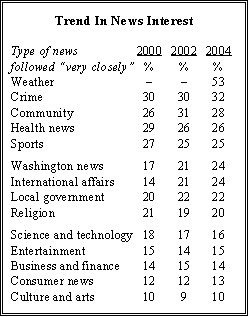 Health news is followed more closely by older people; 34% of people over age 50 pay very close attention to health news compared with just 20% of people under age 30. And a third of women say they follow health news very closely compared with 18% of men.
Health news is followed more closely by older people; 34% of people over age 50 pay very close attention to health news compared with just 20% of people under age 30. And a third of women say they follow health news very closely compared with 18% of men.
Common Concerns Weather, Health
Clearly, education is a very important factor in the public’s news interests. College graduates make up a disproportionate percentage of the hard news audience and, in particular, the growing audience for international news.
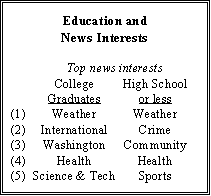 However, while people with a high school education display much more interest in weather news than do college graduates (58% vs. 45%), the weather tops the list of news subjects for both groups. Similarly, health news is among the leading interests of high school-educated people and college graduates.
However, while people with a high school education display much more interest in weather news than do college graduates (58% vs. 45%), the weather tops the list of news subjects for both groups. Similarly, health news is among the leading interests of high school-educated people and college graduates.
Otherwise, their leading news interests are quite different. Community news, crime and sports news rate among the subjects that most interest people with a high school education; international affairs, Washington news and science and technology are among the leading topics for college graduates.
Stewart Verdict Widely Known
About eight-in-ten Americans (79%) were able to recall that Martha Stewart was found guilty in her recent trial. There also is broad awareness of the name of the terrorist group that carried out the Sept. 11 attacks. In an open-ended format, 71% volunteered al Qaeda or cited Osama bin Laden.
By comparison, 56% know that the Republicans currently maintain a majority in the House of Representatives. And about the same number (55%) are able to correctly estimate the current number of U.S. military deaths in Iraq as between 500 and 1,000 (the survey was in the field from April 19 to May 12, 2004). Those who were wrong on this last question were more likely to underestimate the number of casualties (28% said they thought it was under 500) than overestimate (10% though it was 1,000 or more).
While older Americans generally score better than younger people in the knowledge questions, education is an even bigger factor. For example, three-quarters of college graduates (76%) knew that the GOP has a majority in the House, compared with just 44% of those with no more than a high school education.
News Sources and Knowledge
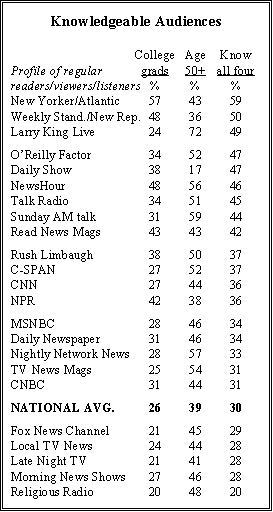 The most knowledgeable audiences for specific news outlets tend to be those where the typical reader, viewer or listener is well-educated, older, or both. For example, roughly six-in-ten (59%) regular readers of literary magazines like the New Yorker and Atlantic answered all four current events questions correctly, highest among regular news audiences. The readership of these magazines also has the greatest proportion of college graduates.
The most knowledgeable audiences for specific news outlets tend to be those where the typical reader, viewer or listener is well-educated, older, or both. For example, roughly six-in-ten (59%) regular readers of literary magazines like the New Yorker and Atlantic answered all four current events questions correctly, highest among regular news audiences. The readership of these magazines also has the greatest proportion of college graduates.
Similarly, the readership for political magazines like the New Republic and Weekly Standard is relatively knowledgeable and well-educated; fully half correctly answered all four questions. By contrast, regular viewers of Larry King Live scored about as well as those who read political magazines (49% all four correct), although just 24% completed college. However, the audience for King’s program includes a much greater proportion of those age 50 and older than the audience for any other source (72%).
Those who say they regularly watch the Daily Show with Jon Stewart are much younger than average just 17% are 50 and older. But they are relatively well-educated 38% are college graduates and are fairly knowledgeable about current events (47% all four correct). Regular viewers of the Daily Show are about as knowledgeable as the regular audiences for the O’Reilly Factor (47%), the NewsHour (46%), talk radio (45%) and Sunday morning political talk shows (44%).
The audiences for cable networks and broadcast TV news outlets, which tend to be broader and more similar demographically to the nation as a whole, are somewhat less knowledgeable than some of these more specialized audiences. Comparable numbers of regular viewers of CNN (36%), MSNBC (34%) and the nightly network news programs (33%) correctly answered all four current events questions. Viewers of the Fox News Channel score almost precisely at the national average (29% answer all four correctly, compared to 30% nationwide), despite having fewer college graduates as regular viewers.


